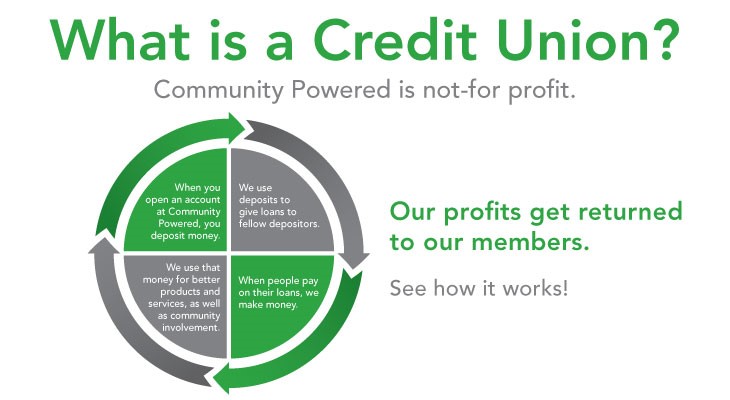Federal Credit Union: High Quality Financial Solutions and Assistance in Wyoming
The Ultimate Overview to Recognizing Lending Institution
Credit score unions stand as distinct economic entities, rooted in concepts of common support and member-driven operations. As we browse through the details of credit scores unions, an insightful journey awaits to lose light on these member-focused institutions and how they differ from traditional financial institutions.
What Are Credit History Unions?
Credit unions are member-owned banks that offer a range of banking services to their members. Unlike traditional banks, lending institution operate as not-for-profit organizations, meaning their key emphasis gets on serving their members instead than making the most of profits. Participants of a credit union generally share a common bond, such as helping the very same employer, coming from the exact same community, or becoming part of the exact same organization.
One of the vital benefits of cooperative credit union is that they typically supply greater interest rates on financial savings accounts and reduced rates of interest on lendings contrasted to financial institutions. Hybrid Line of Credit. This is since credit rating unions are structured to profit their participants straight, allowing them to hand down their earnings in the form of better rates and fewer fees. Furthermore, cooperative credit union are known for their individualized customer care, as they prioritize developing partnerships with their participants to understand their one-of-a-kind economic needs and objectives
History and Evolution of Credit Report Unions
The roots of member-owned monetary cooperatives, recognized today as lending institution, trace back to a time when communities looked for choices to standard financial institutions. The concept of lending institution come from the 19th century in Europe, with Friedrich Wilhelm Raiffeisen frequently credited as the leader of the participating banking movement. Raiffeisen started the very first identified credit union in Germany in the mid-1800s, stressing neighborhood support and self-help concepts.
The development of lending institution proceeded in North America, where Alphonse Desjardins developed the very first cooperative credit union in Canada in 1900. Quickly after, in 1909, the first united state credit score union was formed in New Hampshire by a team of Franco-American immigrants. These early cooperative credit union operated on the essential concepts of mutual aid, democratic control, and participant ownership.
With time, lending institution have grown in appeal worldwide because of their not-for-profit structure, concentrate on offering participants, and offering competitive financial products and solutions. Today, lending institution play an essential role in the monetary industry, supplying accessible and community-oriented financial options for people and companies alike.

Subscription and Qualification Requirements
Membership at a credit report union is typically restricted to people fulfilling details qualification criteria based on the organization's founding concepts and governing demands. Some credit history unions may just offer people who live or work in a certain location, while others may be tailored to read the full info here employees of a certain company or participants of a certain organization.
In addition, lending institution are structured as not-for-profit companies, meaning that their primary goal is to offer their participants instead than create revenues for shareholders. This concentrate on participant service typically equates into more personalized focus, reduced charges, and competitive interest rates on finances and cost savings accounts. By satisfying the qualification requirements and ending up being a participant of a lending institution, people can access a series of economic services and products customized to their specific requirements.
Services and Products Provided
One of the crucial facets that sets lending institution apart is the varied variety of economic services and products they supply to their members. Debt unions normally provide typical banking solutions such as cost savings and examining accounts, car loans, and charge card. Members can additionally take image source advantage of financial investment solutions, consisting of retirement accounts and financial planning assistance. Numerous cooperative credit union use affordable rates of interest on interest-bearing accounts and fundings, as well as reduced costs contrasted to conventional financial institutions.
In addition, cooperative credit union usually supply practical online and mobile financial choices for members to conveniently manage their financial resources. They might offer rewards such as common branching, enabling participants to access their accounts at other credit score unions throughout the nation. Some credit report unions also supply insurance coverage products like auto, home, and life insurance to assist participants safeguard their properties and loved ones.

Benefits of Banking With Lending Institution
When thinking about monetary institutions, discovering the advantages of banking with credit scores unions reveals unique advantages for members looking for individualized service and competitive prices. Unlike large banks, credit report unions are member-owned and prioritize structure solid connections with their participants. In general, financial with a debt union can supply a more personalized, cost-efficient, and member-centric monetary experience.
Verdict
In verdict, credit scores unions stand out as member-owned monetary organizations that focus on offering their participants over maximizing revenues. With origins dating back to 19th century Europe, credit score unions adhere to concepts of shared help and participant possession.
Debt unions are member-owned economic institutions that offer a range of financial services to their members. The concept of credit history unions come from in the 19th century in Europe, with Friedrich Wilhelm Raiffeisen commonly attributed as the leader of the cooperative financial motion.The development of credit report unions continued in North America, where Alphonse Desjardins developed the initial credit history union in Canada in 1900. Credit report unions normally offer traditional financial services such as cost savings and examining accounts, lendings, and credit cards.When taking into consideration financial establishments, checking out the benefits of banking with credit unions exposes unique benefits for participants seeking individualized service and competitive prices.